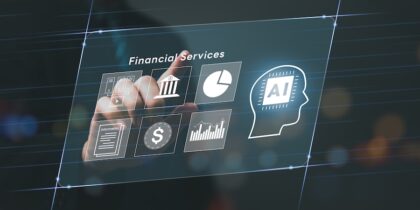In this News Insight, American Banker takes an in-depth look at the impact AI could have on jobs in the banking sector. As technology changes the the way financial firms operate, mobile workforce solutions will be critical. —Samsung Insights editorial team
The idea of artificial tends to strike fear in the hearts of workers who suspect they’ll be replaced by robots.
The reality is more nuanced. There is no question some jobs will be lost. But others will be created, and still others will morph into something different — bot designer, bot supervisor, soother of the most irate customers. In some cases, AI will just take on extra work nobody wants to do.
In one example of the latter, First National Bank of Wynne in Arkansas has been using robotic process automation, the lowest-IQ form of AI, to help with acquisitions.
“When you acquire a bank, one of the biggest cost expenses is the core conversion piece,” explained Bart Green, senior vice president.
All customer and account information, including for cards, internet banking and cash management, has to be migrated to the acquiring bank’s core system. It is time-consuming.
A consultant told them about RPA software from EnableSoft called Foxtrot. Other providers of RPA software include Blue Prism, UiPath and WorkFusion.
RPA software can be set up to perform tasks the way a human would — it can log into software by entering a username and password, it can click on a client record, then log into another piece of software, locate a data field and copy and paste that data into the first page. It can be set up so you can watch it on a desktop, and it looks as if a ghost were operating the computer.
“You could teach it, just like you would teach an employee, how to input information into systems, and it can do it efficiently and quickly,” Green said. It’s better at reporting errors and validating data.
Using the software has saved the bank 70% in conversion costs, he said.
Now the bank is beginning to find other uses for the software.
“It’s a matter of thinking of what kinds of manual, time-consuming processes do we have today and how can we automate them?” Green said.
For instance, the bank recently had to mass reissue debit cards due to a breach. That could be done by bots.
The RPA software has not affected jobs so far at the bank because it is being used for one-off, time-consuming projects like mergers, Green said.
“I’ve yet to put it in place to replace a daily duty,” he said. “I can see that occurring. I’m just beginning to start peeling away the layers of that possibility.”
He could also see hiring someone in IT who has experience with RPA software to help figure out new uses for it.
“It may end up canceling out jobs — you’re creating a job that does this task to remove the task required by another employee,” Green noted.
What jobs will be lost, gained?
Some bankers and observers have suggested that only the boring parts of jobs, drudgery like data entry and filling out forms, will disappear so the humans will be able to focus on more interesting tasks, and that no actual jobs will be lost.
Bank employees themselves seem to think this. In an Accenture survey released last week of 1,300 nonexecutive bank employees, 67% said they believe AI will improve their work-life balance, and 57% expect it will expand their career prospects.
But Autonomous Research also issued a report last week that estimated that in the U.S. alone, 2.5 million financial services employees will be “exposed” to AI technologies in the front, middle and back office — 1.2 million working in banking and lending, 460,000 in investment management, and 865,000 in insurance.
“These functions will see 20-40% productivity gains, or unemployment, depending on your vantage point,” the report stated. About $1 trillion in costs will be exposed to AI transformation in financial services sectors by 2030, according to the report; $450 million of this would in banking.
In banking, 70% of front-office jobs will be dislocated by AI, the researchers say: 485,000 tellers, 219,000 customer service representatives, and 174,000 loan interviewers and clerks. They will be replaced by chatbots, voice assistants and automated authentication and biometric technology.
And 96,000 financial managers and 13,000 compliance officers will be laid off as AI-based anti-money-laundering, anti-fraud, compliance and monitoring software fills in. Another 250,000 loan officers will lose their jobs to AI-based credit underwriting and smart contracts technology.
However, Accenture’s study last week of AI’s impact on jobs in financial services presented a rosier job picture. It concluded that there will be a net gain in jobs among companies that deploy AI wisely, of 14%; they will also increase revenues by 34% by 2022.
One source of new revenue will be automated advice that helps people do things like save more or invest more lucratively, the way Netflix and Amazon recommend movies and products. This could lead to wallet consolidation and cross-sales.
“There will be roles that AI will eliminate,” said Alan McIntyre, a senior managing director at Accenture and head of the company’s banking practice. “But we do think that deployed properly it will create opportunities as well.”
For instance, banks that use AI software to generate suspicious activity reports will most likely create new jobs around explaining AI to regulators.
“The regulators are not going to be big advocates of black box decision-making that is not easily explained,” McIntyre noted.
Where will entry-level jobs exist?
As teller, AML, and other jobs become automated by RPA and AI, where will people right out of school or people with disabilities find entry-level jobs?
“It’s a difficult question,” said Lex Sokolin, global director of fintech strategy at Autonomous. “This is a question that has to go to the heart of every CEO of a large financial firm that hires AI software to replace human jobs, and it goes on the shoulders of the founders and developers that are building the software. If you have created real structural unemployment by building out successful software, you have to think about your employees as stakeholders in the project.”
McIntyre suggested the entry-level jobs will now be in technology.
“One can see the way digital-native companies are hiring people out of college with programming capability,” he said. “I do think the idea of starting as a teller and working your way to CEO is troubled.”
What about people who are not good at math, science and programming?
“There still will be roles where human empathy and the ability to connect are important,” McIntyre said. If someone has $100,000 to invest, for instance, an app might be able to suggest an asset allocation. But if it is an inheritance from a parent who just died, the interaction will take some sympathy.
“Those types of conversations will require people to have a high emotional quotient, to be able to read and react to people and guide the conversation,” McIntyre said.
Which has a higher EQ — human or bot?
Not everyone believes that humans are better at emotional work, like dealing with a sad or irate customer.
Sokolin argued that AI systems are good at emotional labor. He pointed to the debt-collection fintech TrueAccord, whose AI engine handles collections work for banks and card issuers.
“All they do is emotional labor, and they’re much better at it than people who call you during dinner,” he said.
Ohad Samet, CEO of TrueAccord, said technology is good at avoiding tense situations in a way that humans are not.
“People in the collections industry like to say that people collect from people, but the reality is that collectors are human and subject to human biases: they get angry, they get tired,” he said.
“If the person in debt is abusive on the phone, which is not uncommon, they have an emotional response. The software is not subject to that,” Samet said. “It uses the best channel, the best content, the best offer at the right time, and it doesn’t get offended or misbehave if somebody yells at it or writes something nasty back, which happens.” And the software does have some empathy built in.
Though using AI requires fewer human collectors, Samet pointed out that such jobs are little fun and pay badly. And customers do not want to talk to human collections agents anyway.
“The world is changing,” he said. “We’re not the ones making that change. The preferences of consumers are changing the collections industry.”
TrueAccord is an example of some of the new jobs being created by AI. It has a growing customer engagement team, who help people who call in or email. Some employees write the content the chatbots present. Others are data scientists who work to tune the experience to the needs of consumers.
Chatbot backlash
A few banks have introduced chatbots to do work that might otherwise be done by customer service people. Bank of America’s erica is one example. USAA’s Alexa skill is another.
There has also been some chatbot controversy and backlash. There was Microsoft’s Tay, which spewed racist nonsense to customers. The fintech startup Digit, which offers automated saving and credit card debt paydown, no longer makes a chatbot the primary means of interacting with its app. For the simple tasks Digit customers do, it did not seem to be the right approach.
Sokolin noted that different tools make sense for different purposes. To obtain an account balance, a simple login and tap is logical. Opening Facebook Messenger and asking it is not.
Like many bankers, Green has hesitated to deploy a customer-facing chatbot, comparing this to replacing a front-desk receptionist with an electronic menu that has to be navigated.
“You may still get the results you need, but the question will be, how well will AI differentiate the party on the other line’s emotional feelings on their problem?” he said. “If the customer is upset, happy, or excited, how will AI be able to accommodate that situation? It’s impressive to see Amazon Echo understand different dialects, but will it be able to understand emotional aspects of that conversation?”
Green said there is also reputational risk.
“If a person makes a mistake, you can fire them,” he said. “If the AI keeps making mistakes, you have a huge reputational risk that’s hard to overcome. Are you going to fire your AI?”
Partly for these reasons, some banks are making chatbot technology available to their employees, to help them be more efficient. For instance, Morgan Stanley has equipped its financial advisers with AI software that sifts through client data and records to help suggest recommendations.
Retraining the workforce
Accenture’s survey of bankers found that only 3% are investing in retraining their workers to prepare them for the AI-riddled workplace.
McIntyre said this is because the technology is still new and banks are just testing the use of AI in areas like trading, lending, and customer service; they are not yet looking at the bigger picture.
Banks need to help employees make the transition to AI, Sokolin said. They might implement software that enables blue-collar workers to be programmers with the use of visual tools, for instance.
Colleges may need to do more to prepare people for AI.
Royal Bank of Canada has called for a national review of college programs to ensure they place more of a focus on “human skills” like active listening, critical thinking and social perceptiveness.
The bank’s research has found these skills will help position future workers to complement increasingly pervasive technologies like robots and machines, rather than compete with them.
Sokolin is less worried about the younger generation than the older generation that might have a harder time shifting to AI-assisted work and who have more at stake with high debt and low savings.
“It becomes a fairly anxious picture,” he said. “That is the responsibility of the employer. People have to raise their hand and say we’ll do something to fix or soften it.”
Executives safe for now
Bank executives’ jobs appear to be safe from AI for now. Vendors are not suggesting their software can do C-suite work.
And AI is bad at context switching, according to Sokolin.
“Today AI is very narrow,” he said. “You pick a direction you want it to hammer. You teach it the outcome you want, and it can generally create that outcome.”
An executive might use a spreadsheet for a little while, then manage a relationship, then run a business development meeting, then deal with an upset client whose LLC is going bankrupt.
“All these things require a lot of different skill sets,” Sokolin said. “In today’s institutions at the senior management levels, there’s a lot of that type of context switching.”
But as AI gets more broadly adopted, managing people will take different skill sets at the senior level.
And an interesting question may become: If you’re managing fewer people and more bots, what does that do to your power base in an organization?
Editor at Large Penny Crosman welcomes feedback at penny.crosman@sourcemedia.com.
This article was written by Penny Crosman from American Banker and was legally licensed through the NewsCred publisher network. Please direct all licensing questions to legal@newscred.com
Download our financial technology study to learn how retail banks can thrive in a digitally transformed economy.
![]()








